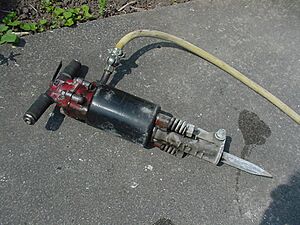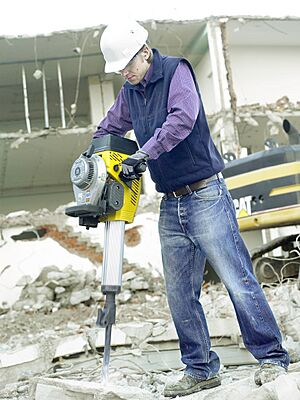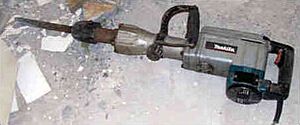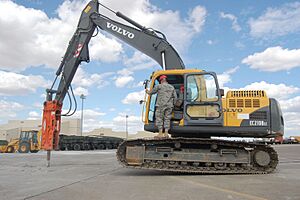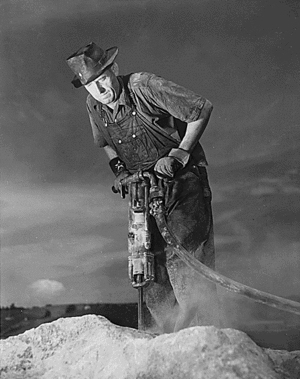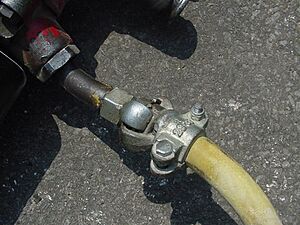Jackhammer facts for kids
A jackhammer is a powerful tool that combines a hammer with a chisel. It's also known as a pneumatic drill or demolition hammer, especially in Britain. Jackhammers are used to break up hard materials like rock, pavement, and concrete.
Most hand-held jackhammers get their power from compressed air. Others use electric motors. Bigger jackhammers, like those on construction machines, often use hydraulic power. The tool works by moving an internal hammer up and down very fast. This hammer hits a chisel, which then breaks the hard surface. The harder you push, the more effective the jackhammer is.
Contents
The History of Jackhammers
The idea for powerful drills started a long time ago. The first steam-powered drill was patented in 1806 by Samuel Miller. These early drills only used steam to lift the drill bit.
The need for better drills grew with mining, quarrying, and tunnel building. In 1844, C. Brunton suggested a drill powered by air. In 1849, Jonathan J. Couch of Philadelphia, Pennsylvania patented an American "percussion drill." His drill used a steam engine piston to throw the drill bit against the rock.
Joseph W. Fowle, Couch's assistant, improved on this. By 1850 or 1851, Fowle was using compressed air to power his drill. This made it the first true pneumatic drill.
Why Compressed Air Was Important
Miners and tunnel builders really needed pneumatic drills. Steam engines needed fires, which created fumes. These fumes were dangerous in mines and tunnels, where fresh air was scarce. Also, mines could have explosive gases like methane. Steam couldn't travel long distances without cooling down.
Compressed air was different. It could be sent over long distances without losing power. After powering the equipment, the used air could even help ventilate the mine or tunnel.
European Innovations
In the late 1840s, the King of Sardinia, Carlo Alberto, wanted to build a long tunnel through Mount Fréjus. This tunnel would connect Italy and France by rail. This big project showed the clear need for mechanical rock drills.
In 1851, a Frenchman named François Cavé designed a compressed air drill. But it wasn't very successful because the air had to be added by hand for each hit.
In 1854, Thomas Bartlett in England patented a rock drill. He showed his drill, powered by compressed air, to officials working on the Mount Fréjus tunnel. By 1861, engineer Germain Sommeiller and his team refined Bartlett’s drill. Sommeiller then used his improved drill for the long Gotthard Tunnel in the Alps. This helped mining and tunnel building grow rapidly.
Today, companies like Atlas Copco and Ingersoll Rand are leaders in making compressed air drilling tools.
Different Names for Jackhammers
The word "jackhammer" is commonly used in North American English and Australia. In other English-speaking countries, people often say "pneumatic drill." However, "pneumatic drill" specifically means a jackhammer powered by compressed air.
In Britain, electric versions are sometimes called "Kangos." This name comes from a well-known brand.
It's also important to know the difference between a drill and a breaker.
- A breaker (or demolition hammer) uses pure hitting power to break material. It doesn't spin its chisel.
- A drill both hits and spins its bit. This allows it to cut into very hard rock, like granite, often to make holes for blasting.
Breakers are usually used for construction and road repair. Drills are more common in mining or quarrying.
How Jackhammers Are Used
Using a full-sized jackhammer against walls or steep slopes can be hard. The user has to hold the tool's weight and push it back against the surface after each hit.
Experienced workers sometimes use a "two-man team" for this. One person operates the jackhammer, and the second helps by holding it up or cradling it. Together, they use their combined weight to push the bit into the work surface. This is often called horizontal jackhammering.
Another method is overhead jackhammering. This needs a lot of strength to hold a smaller jackhammer, called a rivet buster, above your head. To make overhead work safer, special platforms can be used. These platforms can take the tool's weight and vibrations away from the user.
Types of Jackhammers
Jackhammers come in different types, depending on how they get their power.
Pneumatic Jackhammers
A pneumatic jackhammer uses compressed air as its power source. This air usually comes from a portable air compressor. These compressors are often driven by a diesel engine and are mounted on a trailer.
Older compressors had two speeds: idling (when not working) and maximum (when working). Modern ones use advanced compressors and have more flexible speed controls. Some setups also include an electrical generator for lights or other electric tools.
Some users add a special lubricator to the air hose. This helps the jackhammer last longer and work better.
Electromechanical Jackhammers
An electromechanical hammer, often called a rotary hammer, has an electric motor. This motor turns a crank, which moves a drive piston back and forth. This drive piston compresses air inside the tool. The compressed air then pushes a "free-flight" piston, which hits a striker, and the striker hits the drill bit.
These electric tools come in various sizes, from about 12 to 65 pounds. They need an electric power source but don't need a separate air compressor. In the past, they weren't as powerful as air-powered hammers. However, newer models with brushless motors are becoming much stronger, sometimes matching pneumatic tools.
Electric jackhammers are great for places where a compressor is hard to use. This includes inside buildings, crowded construction sites, or remote areas. They use different ways to attach chisels, like SDS-max or hex connections. The size of the connection often relates to how much breaking power the tool has.
Hydraulic Jackhammers
A hydraulic breaker is a large jackhammer often attached to heavy equipment like an excavator or backhoe. These are widely used for roadwork, quarrying, construction, and demolition. They are called rig-mounted or machine-mounted breakers.
These tools can work horizontally because they don't rely on gravity. They usually have a hydraulic motor that powers a sealed pneumatic hammer system. This design helps prevent strong shocks from damaging the hydraulic pump system.
There are also portable hydraulic breakers. These connect to a portable hydraulic power pack, which has an engine driving a hydraulic pump. Or, they can connect to a mini-excavator's hydraulic system. Hydraulic power is more efficient than air compressors. This means hydraulic kits can be smaller, cheaper, or more powerful than similar pneumatic ones.
Both pneumatic and hydraulic tools are often used in underground mines. This is especially true where there's a risk of explosions, like in coal mines. They don't need high-voltage electricity, which reduces the danger of sparks.
Jackhammer Bits
Jackhammers use different types of bits, or chisels, for various jobs:
- Spade: Gives a flat finish for concrete or helps with edging in asphalt or dirt.
- Flat tip: Allows for better control or a finer edge.
- Point: Used for general breaking of hard materials.
- Stake driver: Used to drive concrete form stakes into the ground.
- Scabbler: Smooths surfaces or cleans them before adding new material.
- Flex chisel: A flexible metal blade for removing tiles or scraping.
- Bushing tool: Has multiple carbide points for cleaning up seams or smoothing rough concrete.
Bits can be sharpened, but after sharpening, they need to be heat-treated to make the steel strong again. Some bits are designed to sharpen themselves as they are used.
Staying Safe While Using a Jackhammer
Jackhammers are very loud. The sound of the hammer hitting, plus the air escaping, can be over 120 dB SPL near the operator's ears. This is dangerously loud. Operators must wear sound-blocking earmuffs and earplugs to protect their hearing. Without protection, they can develop tinnitus, which is a ringing in the ears. Even with some jackhammers having silencers, the hammer blows and compressor noise are still very loud.
Using a jackhammer for a long time can also cause problems with your hands and arms. The strong vibration from the tool can lead to a condition called vibration white finger. This makes your fingers turn white and feel numb or tingly. It can also increase the risk of carpal tunnel syndrome, which affects nerves in the wrist.
Some newer electric jackhammers have special systems to reduce the vibration felt by the operator. This makes them safer and more comfortable to use.
When breaking up concrete, jackhammers can create a lot of dust. This dust can contain tiny bits of silica, which can be harmful if breathed in. Breathing this dust can lead to a lung disease called silicosis. Because of this, operators and anyone nearby should wear special protective gear, including a respirator, to protect their lungs.


